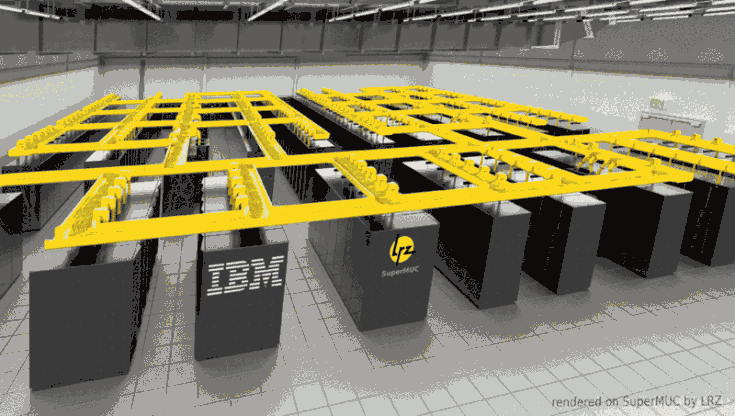An offspring of IBM , the SuperMUC ranks fourth in terms of computing power in the world, but claims top spot in the Europe, boasting an aggregate peak performance of more than 3 Petaflops of computing power.
The super computing power translates into 3 quadrillion floating point operations per second. And it has more than 330 terabytes of main memory built in for data processing. These data can be transferred between nodes via a non-blocking InfiniBand network with fa tree topology.
On top of that, up to 10 Petabytes of data can intermediately be stored in parallel file system based on IBM’s GPFS. The storage solution of NetApp with more than 4 Petabytes capacity is used for permanent data storage of such user data as source code and input data. For long-terms data archiving, generic old-fashioned magnetic tape libraries are also in use.
The SuperMCU is a System X iDataPlex from IBM., and is mainly designed to perform scientific questions in physics and fluid dynamics. According to professor Arndt Bode for computer technology and computer organization at Technische Universitaet Muchen, the SuperMUC incorporates processors with a standard instruction set that are well known from laptops, PCs and servers, so that it is user-friendly.
Yet, the grid of 155,550 processors is a big source of over heat. To solve the heat problem, the SuperMUC incorporates innovative warm-water cooling system, modeling after human body circulation system.
Initiated by IBM, the system leads to 40% less energy consumption than traditional air-cooled machines. The system doesn’t waste the hear energy, but rather converts the heat energy to drive up the central-controlled heating system of the buildings of the Leibniz Supercomputing Center Campus that houses the SuperMUC.

The installation of SuperMUC was part of a ceremony to celebrate the 50th anniversary of the Leibniz-Rechenzentrum(LRZ) of the Bavarian Academy of Sciences in Garching, Germany.
“SuperMUC is many times more efficient than its predecessors. Where it makes sense, we use frequency scaling, a Linux kernel function delivered with SUSE Linux Enterprise, which allows us to run applications at their optimal operating point. This means we sue wherever possible, newly developed energy efficiency mechanisms in Linux, said Dr. Herbert Huber, head of high-performance systems at the LRZ.
The Leibniz-Rechenzentrum (LRZ) of the Bavarian Academy of Sciences on the research campus in Garching is the service provider in the field of information processing for the Munichuniversities.
Together with the Munich Scientific Network (MWN), it provides a powerful communication infrastructure for the sciences and operates extensive backup systems (archiving and backup). In addition, the LRZ is a national supercomputing center and part of the Gauss Centre for Supercomputing, formed by the three national super-computing associations (Garching, Jülich, Stuttgart)

